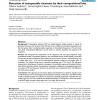Free Online Productivity Tools
i2Speak
i2Symbol
i2OCR
iTex2Img
iWeb2Print
iWeb2Shot
i2Type
iPdf2Split
iPdf2Merge
i2Bopomofo
i2Arabic
i2Style
i2Image
i2PDF
iLatex2Rtf
Sci2ools
BMCBI
2004
2004
Detection of transposable elements by their compositional bias
Background: Transposable elements (TE) are mobile genetic entities present in nearly all genomes. Previous work has shown that TEs tend to have a different nucleotide composition than the host genes, either considering codon usage bias or dinucleotide frequencies. We show here how these compositional differences can be used as a tool for detection and analysis of TE sequences. Results: We compared the composition of TE sequences and host gene sequences using probabilistic models of nucleotide sequences. We used hidden Markov models (HMM), which take into account the base composition of the sequences (occurrences of words n nucleotides long, with n ranging here from 1 to 4) and the heterogeneity between coding and non-coding parts of sequences. We analyzed three sets of sequences containing class I TEs, class II TEs and genes respectively in three species: Drosophila melanogaster, C
| Added | 16 Dec 2010 |
| Updated | 16 Dec 2010 |
| Type | Journal |
| Year | 2004 |
| Where | BMCBI |
| Authors | Olivier Andrieu, Anna-Sophie Fiston, Dominique Anxolabéhère, Hadi Quesneville |
Comments (0)

